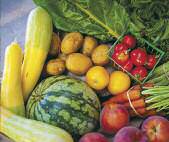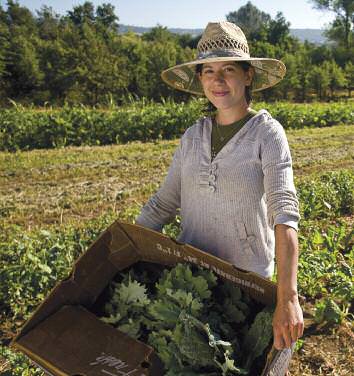edible notables
BEHIND THE BOX
CSAs offer access to healthier, chemical-free food.
WRITTEN BY SUSIE SUTPHIN
PHOTOS BY DAPHNE HOUGARD
The term CSA has become quite popular during the past few years. But it’s important to keep in mind what those three letters stand for.
Even the term “community-supported agriculture” may be a little nebulous. What it really means is, “communities that support their local farmers.” And it typically refers to a program in which members receive weekly boxes of seasonal, locally produced, sustainably grown foods that are purchased directly from farmers.
For many people, the main attraction in signing up for a CSA is having access to healthier, chemical-free food. But as people get to know their farmers, they see the impact their dollars have, not just in producing healthy food but healthy farms, too. CSAs now are a driving force behind the grassroots effort to help communities proclaim their food sovereignty and our human right to participate in and build a regional food system.
Beef Up Our Economy
We all know that buying locally strengthens a regional economy. And food is one of the best ways to do that. Unlike products such as books and clothes, food can and should be locally sourced. It often is one of the few goods a community can locally produce. The more local food we buy, the more money that circulates locally to stimulate the economy.
“We’ve seen an increase in CSA memberships across the region as more farmers are starting to offer CSAs,” says Rick Lattin of Lattin Farms in Fallon and Great Basin Basket CSA. “They are responding to the demand for local food. That is the true CSA market niche.”
Lessons that a CSA program teaches us truly extend outside the box. It educates us about eating in season. Often, the farmer will supply recipes to help us embrace new vegetables such as celery root and unlimited varieties of leafy greens. And eating in season reminds us that vegetables such as tomatoes should not be available in January. That’s why, back in the day, people canned food in order to have their summer flavors all year long.
CSA Event
Slow Food Lake Tahoe hosts an annual event each June at Dragonfly restaurant in Truckee, Calif., called Cooking Outside the Box. With the help of chef/owner Billy McCullough, attendees learn recipes for the seasonal and, sometimes, interesting vegetables found in a CSA box.

There are nearly 30 vegetable, fruit, and/or meat CSAs in the Reno-Tahoe area. For a complete listing, visit https://ediblerenotahoe.com.
Susie Sutphin eats and lives in Truckee, Calif., where she manages the Growing Dome at Truckee Community Farm. Read more about her sustainable food adventures at http://www.Foodchronicles.net.
Resources
Dragonfly
10118 Donner Pass Road (upstairs), Truckee
530-587-0557, http://www.Dragonflycuisine.com
For details about this June’s Cooking Outside the Box event, visit the Slow Food Lake Tahoe events page at http://www.Slowfoodlaketahoe.org.
Recipe
Beet Raviolis with Truffled Goat Cheese
(courtesy of Billy McCullough, chef/owner of Dragonfly restaurant. Serves 4)
3 red beets of similar size
3 yellow beets of similar size
Olive oil (enough to fill two pans containing beets)
2 tablespoons chopped parsley
4 tablespoons kosher salt
2 cloves garlic, chopped
Black pepper to taste
Juice of 3 lemons
Preheat oven to 375 degrees F.
Place beets with tops removed — red in one and yellow in the other so that the colors don’t bleed together — in two deep, heavy, oven-proof pans. Fill each pan halfway with beets. Then, add olive oil until the beets are covered. Add parsley, kosher salt, garlic, black pepper, and lemon juice (half in each pan).
Put the pans in the oven, uncovered, and cook until liquid comes to a boil. Then cover and continue braising for 35 minutes or until you can just easily put a knife into the beet. Cool beets a bit, peel with hands, and then cool completely.
Truffled Goat Cheese Filling
1½ pounds Chèvre (goat cheese) at room temperature
4 tablespoons white truffle oil
4 tablespoons basil, chopped
Mix filling ingredients together.
To make the raviolis, slice beets on a mandoline so they each are about 1/16-inch thick. They should be slightly thicker than transparent. Lay beets out on a sheet tray, putting matching sizes next to each other. Lay about 2 teaspoons of filling in the middle of each beet (may depend on beet size). Use your judgment as to the appropriate amount of filling. Then put a similar-sized beet on top of the goat cheese (the beet slices take the place of ravioli dough). Press down sides to seal the raviolis. It’s not necessary to bake the finished raviolis, though you may opt to for a few minutes if you want to melt the filling.
Top with balsamic glaze.
Balsamic Glaze
Reduce 4 cups of balsamic vinegar until thick and syrupy. Reduce at a simmer, and when you have tight bubbles, it should be done. You’ll have extra glaze left over, but you can put it on strawberries for dessert!


